



Suggested citation: Gupta, Saiba, Kartikey Chaturvedi, Ayushi Kashyap, and Nitin Bassi. 2024. Enabling Circular Economy in Used Water Management in India: A Municipal Index for Assessing Urban Local Bodies’ Performance. New Delhi: Council on Energy, Environment and Water.
This study develops and computes a first-of-its-kind municipal index for evaluating the performance of Indian urban local bodies (ULBs) in used water management. ULBs, being the main authorities responsible for managing urban domestic used water, are the focus of the index. Such an evaluation can provide them with information on areas that require improvement and enable them to formulate strategies to mainstream used water treatment and reuse in Indian cities.
Untreated used water (domestic sewage) is discharged into rivers and lakes, leading to high levels of pollution, which is especially concentrated in the river stretches passing through urban areas. Used water, with safe treatment and reuse, is a highly valuable resource. CEEW estimates suggest that by 2050, over 96,000 million litres per day of treated used water (TUW) will be available for reuse in India.
The objective of this index is to mainstream the reuse of TUW at the ULB level. For this purpose, 503 ULBs from class I (population above 1,00,000) and class II (population of 50,000–99,999) cities of 10 Indian states that have adopted a TUW reuse policy were selected. The states include Andhra Pradesh, Chhattisgarh, Gujarat, Haryana, Jharkhand, Karnataka, Madhya Pradesh, Punjab, Rajasthan, and West Bengal. The ULBs were scored based on an assessment framework developed consisting of 5 themes (Finance, Infrastructure, Efficiency, Data & Information, and Governance) with a total of 25 parameters under them. Based on their composite scores, the ULBs were classified into award categories: Aspiring, Promising, Performing, Leading, and Outstanding, from lowest to highest scores.
In 2021, Indian cities generated over 72,000 million litres of used water (domestic sewage) per day, of which only 28 per cent was actually treated (CPCB 2021). The remaining used water was discharged into natural water bodies, such as rivers and lakes. This is one of the main reasons for high levels of pollution in Indian rivers during non-monsoon months. The pollution load is concentrated in the stretches of rivers passing through urban areas, especially metropolitan cities. Further, the problem of water security is severe in rapidly growing urban areas, where there is increasing pressure on existing freshwater resources to meet the growing water demand. Given the quantum of used water generated in the country, reusing treated used water (TUW) can reduce the pressure on freshwater resources and water demand-supply gap, and improve the water environment in urban areas. Bassi, Gupta, and Chaturvedi (2023) estimate that sewage treatment capacity will be 80 per cent of sewage generation by 2050, making over 96,000 million litres per day of TUW available for reuse in India.
Used water management, therefore, needs to be prioritised as an essential urban service. Urban local bodies (ULBs), which are the implementing authorities responsible for developing and maintaining used water infrastructure and service delivery in Indian cities, need to align with SDG 6.3: “By 2030, improve water quality by reducing pollution, eliminating dumping and minimizing release of hazardous chemicals and materials, halving the proportion of untreated wastewater and substantially increasing recycling and safe reuse globally.” In this context, the Government of India has recently undertaken various initiatives that focus on urban areas, to strengthen used water treatment and promote its reuse, and work towards water pollution abatement. Some of the important ones include the Namami Gange Programme and the Atal Mission for Rejuvenation and Urban Transformation (AMRUT).
Considering the importance of TUW, the objective of this research study was to develop and compute the Municipal Used Water Management (MUWM) Index for ULBs in India, to assess their performance in used water management. For this purpose, 503 ULBs from class I (population above 1,00,000) and class II (population of 50,000–99,999) cities in 10 Indian states that have adopted a TUW reuse policy were selected. The states were Andhra Pradesh, Chhattisgarh, Gujarat, Haryana, Jharkhand, Karnataka, Madhya Pradesh, Punjab, Rajasthan, and West Bengal. These progressive states had adopted reuse policies prior to the formulation of the National Framework on Safe Reuse of Treated Water (SRTW), launched in January 2023 by the National Mission for Clean Ganga (NMCG). As a first-of-its-kind, the MUWM Index highlights the progress made by ULBs in implementing a circular economy approach to urban used water management in India.
To assess the performance of the selected 503 ULBs in the management of used water, a MUWM assessment framework was developed. The framework is based on a themes– parameters–indicators (TPI) approach, consisting of 27 indicators under 25 parameters across 5 themes. The themes and parameters are presented in Figure ES1.
Figure ES1 MUWM assessment framework
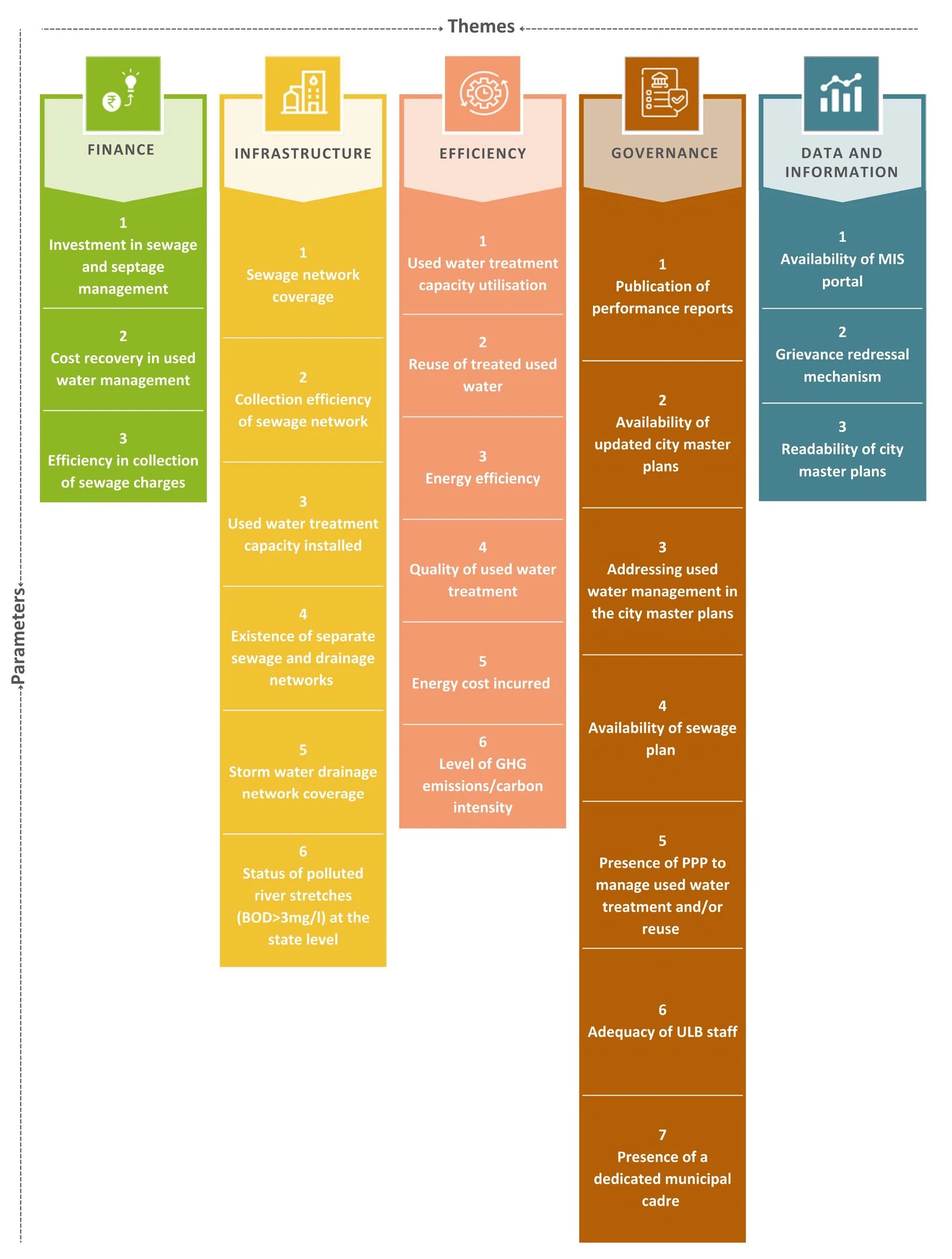
Source: Authors’ analysis
Each of the 25 parameters has one or more corresponding indicators that were used to compute the MUWM index. The indicators are both quantitative and qualitative in nature and are used to assign a score to the ULB, based on its performance in the corresponding parameter. The composite score computed for each ULB is on a scale of 0–5. The methodology used to compute the composite score for the ULBs is shown in Figure ES2.
Figure ES2 Methodology for computing the MUWM index composite score
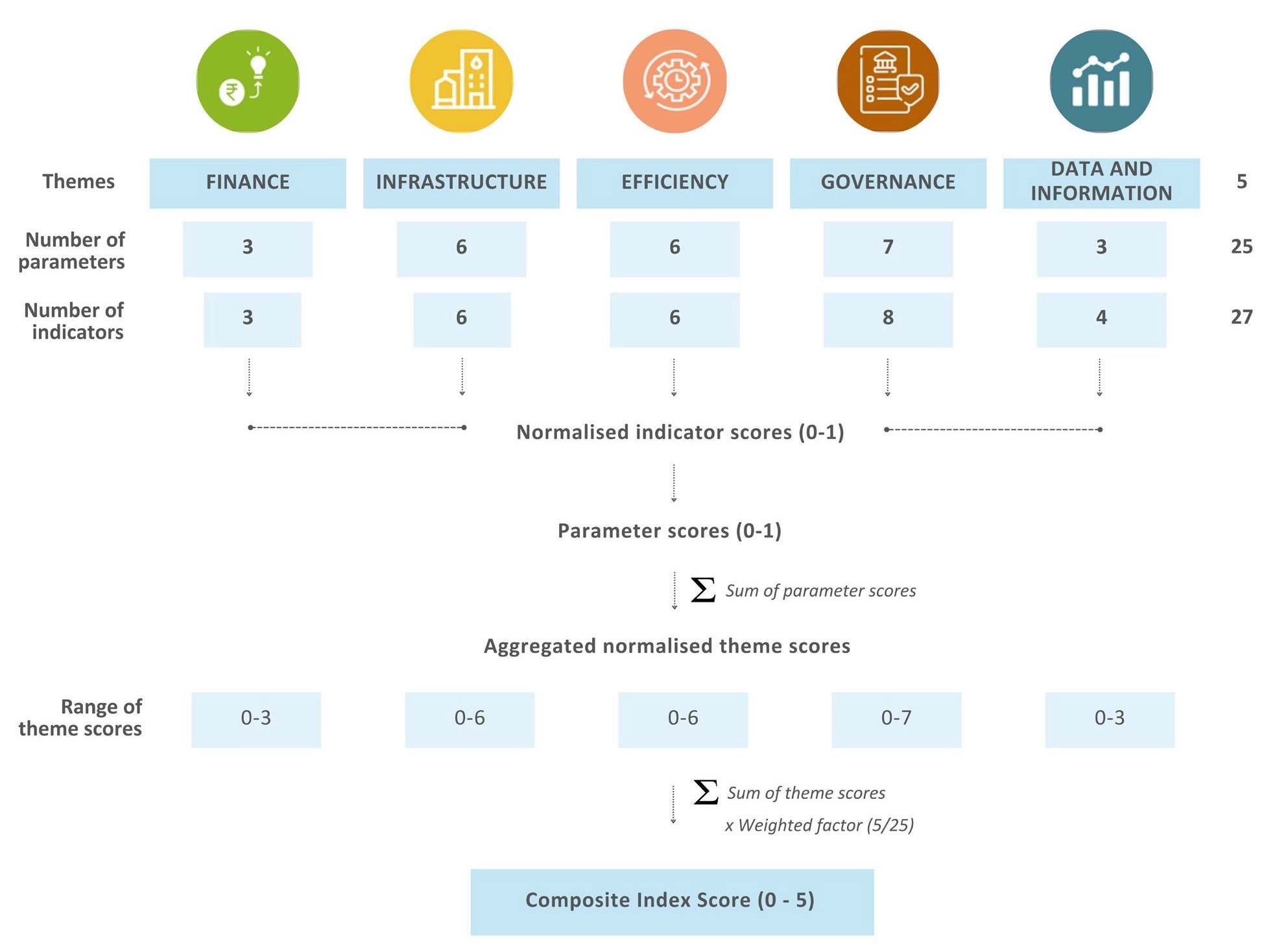
Source: Authors’ analysis
Based on their index composite scores, the 503 ULBs were classified into five award categories, reflecting their performance in used water management (Figure ES3). The categories are Aspiring, Promising, Performing, Leading, and Outstanding, with Aspiring representing the lowest scoring ULBs and Outstanding the highest. The score ranges for the award categories are based on the minimum and maximum composite scores achieved by the ULBs on the MUWM index. Further, the thematic assessment of ULBs is based on theme scores, calculated by aggregating the normalised scores of the individual parameters under each theme. State performance assessment is based on the state scores, calculated by taking the arithmetic mean of the aggregated composite scores of all ULBs considered in that state.
Figure ES3 Key findings of the MUWM index
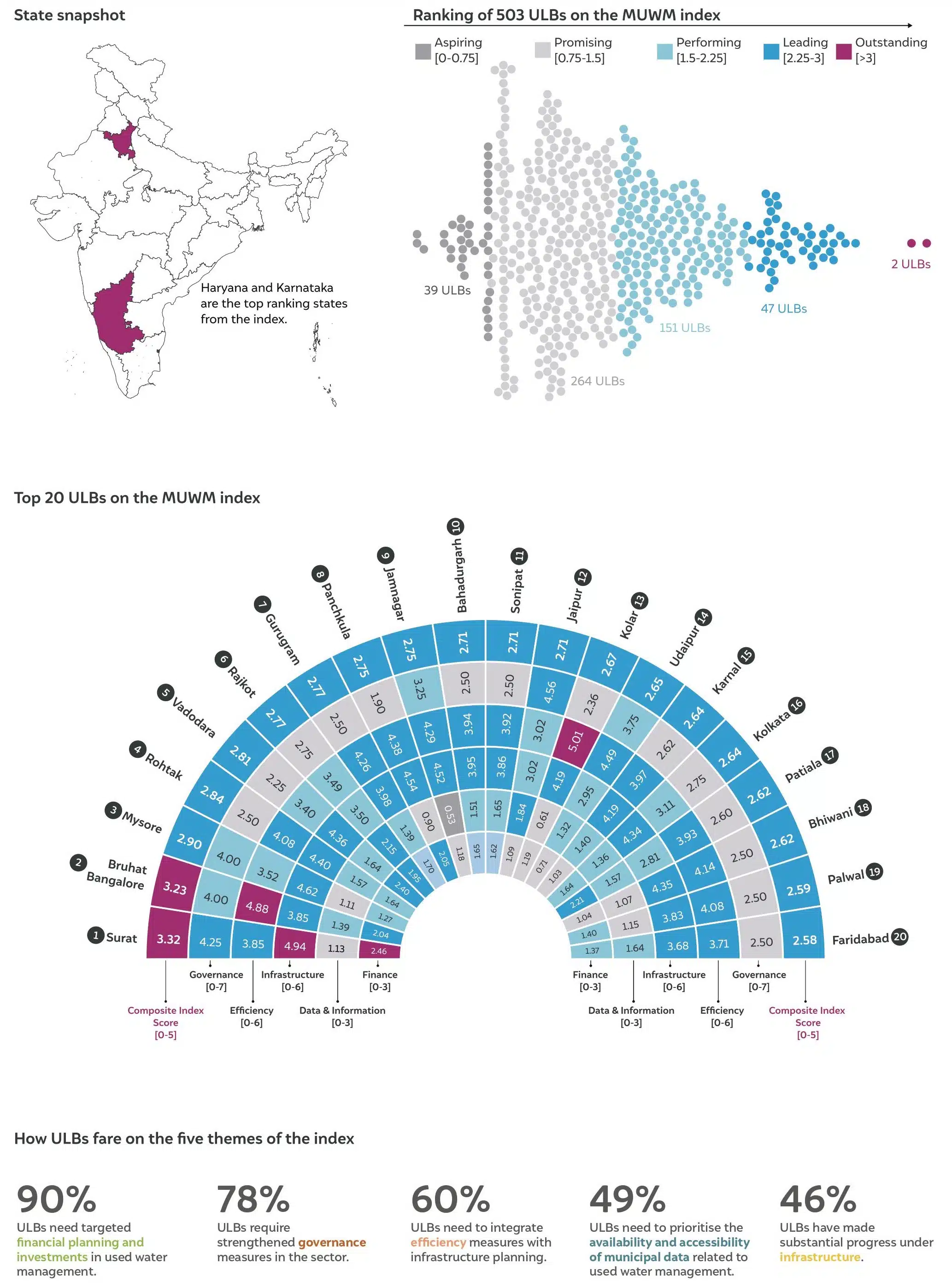
Source: Authors’ analysis
Figure ES4 Haryana and Karnataka are the top scoring states
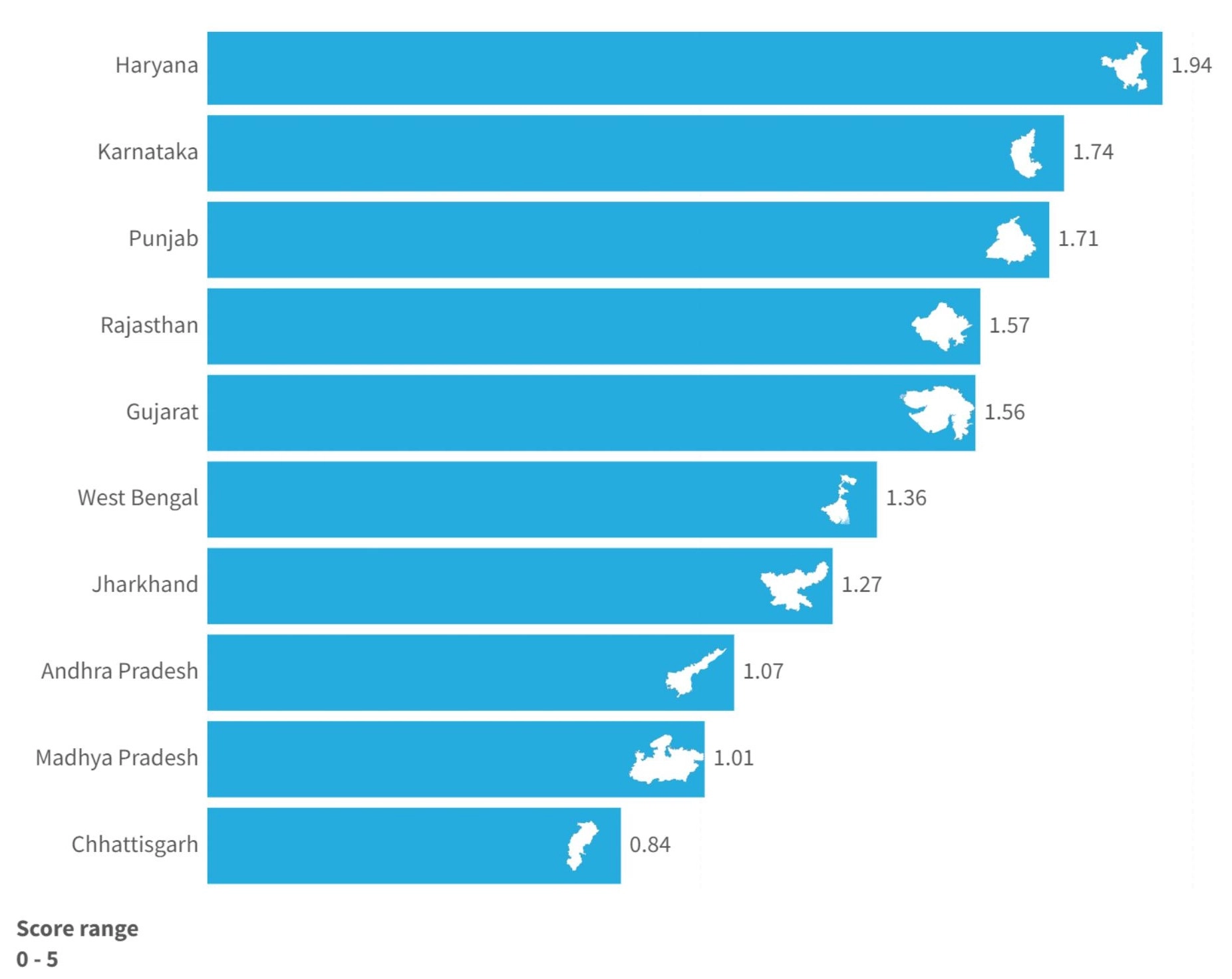
Source: Authors’ analysis
Majority of the ULBs assessed using the MUWM Index have made notable progress in some aspects of used water management and are undertaking significant interventions to improve their performance. However, the reuse of TUW is an essential component of urban used water management, and is yet to be mainstreamed in Indian cities. The following are recommendations for mainstreaming the circular economy approach to urban used water management.
Used water (from toilets, kitchens, bathing/washing) is transported through a piped sewerage network to sewage treatment plants (STPs) which are operated and maintained by local governments.
Based on the level of treatment, it can be reused for various non-potable purposes such as parks and gardens, irrigation, road cleaning, vehicle washing, construction, industries, and waterbody rejuvenation, to name a few.
Urban local bodies (such as municipal corporations and municipal councils), commonly known as municipalities, are the primary authorities responsible for water management in urban areas.
Urban local bodies should be empowered to formulate and adopt long-term used water reuse plans with clearly defined priorities and targets. This is an essential step for mainstreaming used water treatment and reuse in Indian cities.
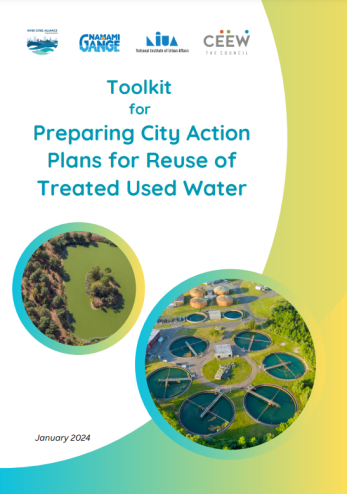
Toolkit for "Preparing City Action Plans for Reuse of Treated Used Water"
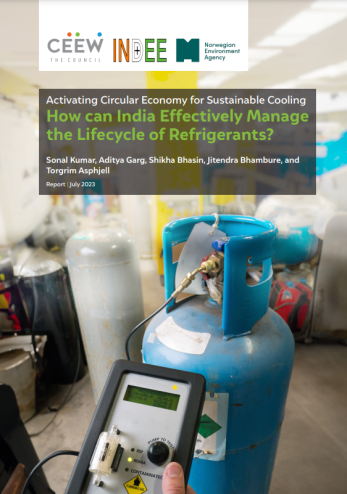
Activating Circular Economy for Sustainable Cooling
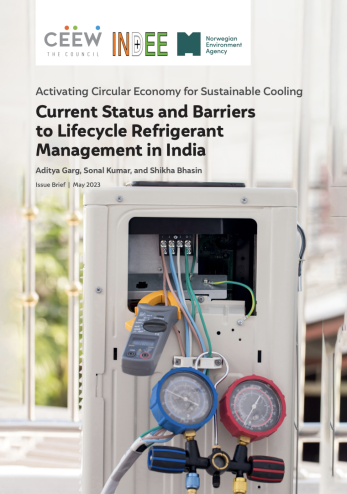
Activating Circular Economy for Sustainable Cooling
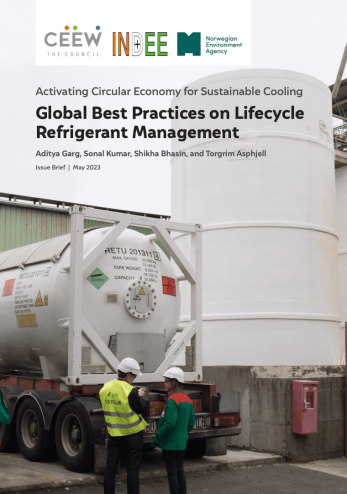
Activating Circular Economy for Sustainable Cooling
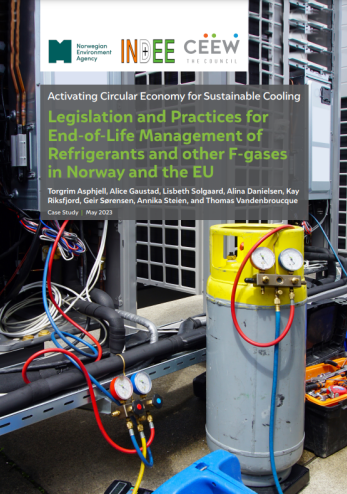
Activating Circular Economy for Sustainable Cooling